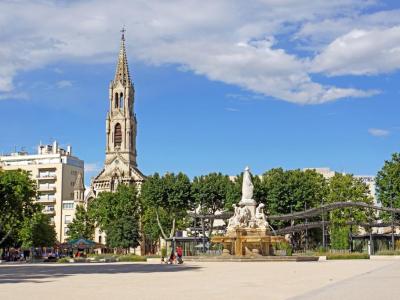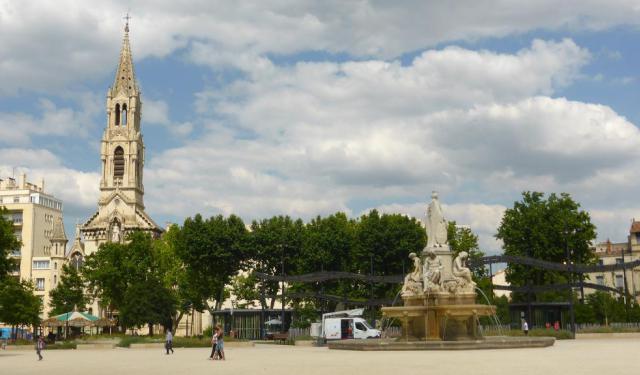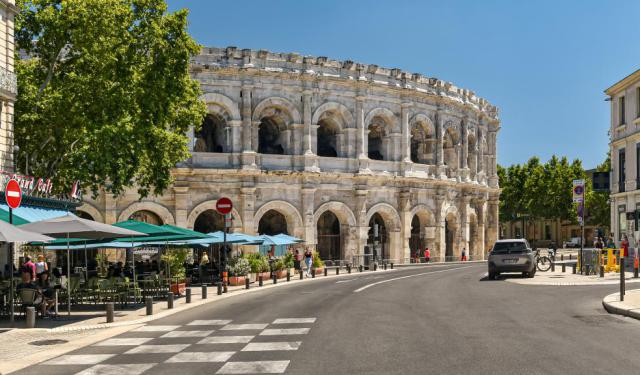
Esplanade Charles-de-Gaulle (Charles de Gaulle Esplanade), Nimes
The Charles-de-Gaulle Esplanade is a grand city square situated just across from the iconic Roman Arena. This expansive square pays tribute to the French soldier, resistance fighter, statesman, and writer Charles de Gaulle (1890-1970), who played a significant role in French history. The creation of this esplanade can be traced back to the first half of the 16th century when the consul Jacques d'Albenas initiated the construction of a platform designed for artillery exercises. Moreover, the square to the south of the crown gate also served as a site for the official reception of notable figures visiting the city.
While certain developments took place during the 17th century, it was only in the 19th century that the esplanade transformed into a genuine place for leisurely strolls. In 1841, the Nîmes municipal council embarked on a project to enhance Avenue Feuchères and the esplanade, which included upgrading the area into the present-day Boulevard de la Libération. This renovation introduced new semi-circular pathways, adorned with clusters of trees, flowers, and balustrades. The development of the esplanade culminated in 1851 with the unveiling of a monumental fountain, a masterpiece by the sculptor James Pradier.
This contemporary esplanade prominently features the Pradier fountain as its central element. The fountain's allegorical depiction represents the city of Nîmes, surrounded by four major rivers in the Nîmes region. Surrounding the pool, there's a spacious triangular stabilized area. To the south, the square offers benches, lawns, Mediterranean flora and trees, as well as bamboo-covered pergolas. Several kiosks, including a branch of the tourist office, enhance the overall experience. Additionally, a 1.40-meter-wide canal commences its course and leads to Avenue Feuchères, ultimately arriving in front of the train station, lined with plane trees.
Several prominent buildings border the esplanade, including the Nîmes Arena to the west, the courthouse to the north, and the churches of Sainte-Perpétue and Sainte-Félicité to the east. This grand square, with its rich history and contemporary beauty, provides a wonderful place for both locals and visitors to enjoy the heart of Nimes and its remarkable surroundings.
While certain developments took place during the 17th century, it was only in the 19th century that the esplanade transformed into a genuine place for leisurely strolls. In 1841, the Nîmes municipal council embarked on a project to enhance Avenue Feuchères and the esplanade, which included upgrading the area into the present-day Boulevard de la Libération. This renovation introduced new semi-circular pathways, adorned with clusters of trees, flowers, and balustrades. The development of the esplanade culminated in 1851 with the unveiling of a monumental fountain, a masterpiece by the sculptor James Pradier.
This contemporary esplanade prominently features the Pradier fountain as its central element. The fountain's allegorical depiction represents the city of Nîmes, surrounded by four major rivers in the Nîmes region. Surrounding the pool, there's a spacious triangular stabilized area. To the south, the square offers benches, lawns, Mediterranean flora and trees, as well as bamboo-covered pergolas. Several kiosks, including a branch of the tourist office, enhance the overall experience. Additionally, a 1.40-meter-wide canal commences its course and leads to Avenue Feuchères, ultimately arriving in front of the train station, lined with plane trees.
Several prominent buildings border the esplanade, including the Nîmes Arena to the west, the courthouse to the north, and the churches of Sainte-Perpétue and Sainte-Félicité to the east. This grand square, with its rich history and contemporary beauty, provides a wonderful place for both locals and visitors to enjoy the heart of Nimes and its remarkable surroundings.
Want to visit this sight? Check out these Self-Guided Walking Tours in Nimes. Alternatively, you can download the mobile app "GPSmyCity: Walks in 1K+ Cities" from Apple App Store or Google Play Store. The app turns your mobile device to a personal tour guide and it works offline, so no data plan is needed when traveling abroad.
Esplanade Charles-de-Gaulle (Charles de Gaulle Esplanade) on Map
Sight Name: Esplanade Charles-de-Gaulle (Charles de Gaulle Esplanade)
Sight Location: Nimes, France (See walking tours in Nimes)
Sight Type: Attraction/Landmark
Guide(s) Containing This Sight:
Sight Location: Nimes, France (See walking tours in Nimes)
Sight Type: Attraction/Landmark
Guide(s) Containing This Sight:
Walking Tours in Nimes, France
Create Your Own Walk in Nimes
Creating your own self-guided walk in Nimes is easy and fun. Choose the city attractions that you want to see and a walk route map will be created just for you. You can even set your hotel as the start point of the walk.
Nimes Introduction Walking Tour
Dubbed the most Roman city outside Italy, Nimes, a small city in Southern France, is steeped in history that harks back to the days of the mighty Roman Empire.
The name itself holds clues to the city's origin, reflecting Celtic roots and connection with the local god, Nemausus, associated with a healing spring.
The hill of Mount Cavalier, once an oppidum, served as the birthplace of... view more
Tour Duration: 1 Hour(s)
Travel Distance: 1.8 Km or 1.1 Miles
The name itself holds clues to the city's origin, reflecting Celtic roots and connection with the local god, Nemausus, associated with a healing spring.
The hill of Mount Cavalier, once an oppidum, served as the birthplace of... view more
Tour Duration: 1 Hour(s)
Travel Distance: 1.8 Km or 1.1 Miles
Ancient Roman Ruins in Nimes
Nicknamed “the French Rome,” the southern French town of Nimes is indeed the most Roman city outside of Italy. In large part, this is due to a wealth of architectural monuments that have remained here since the Roman era. Some ruined and some well-preserved, they offer a captivating glimpse into the ancient history stretching back to the early days of Roman expansion.
A true testament to... view more
Tour Duration: 2 Hour(s)
Travel Distance: 3.7 Km or 2.3 Miles
A true testament to... view more
Tour Duration: 2 Hour(s)
Travel Distance: 3.7 Km or 2.3 Miles


